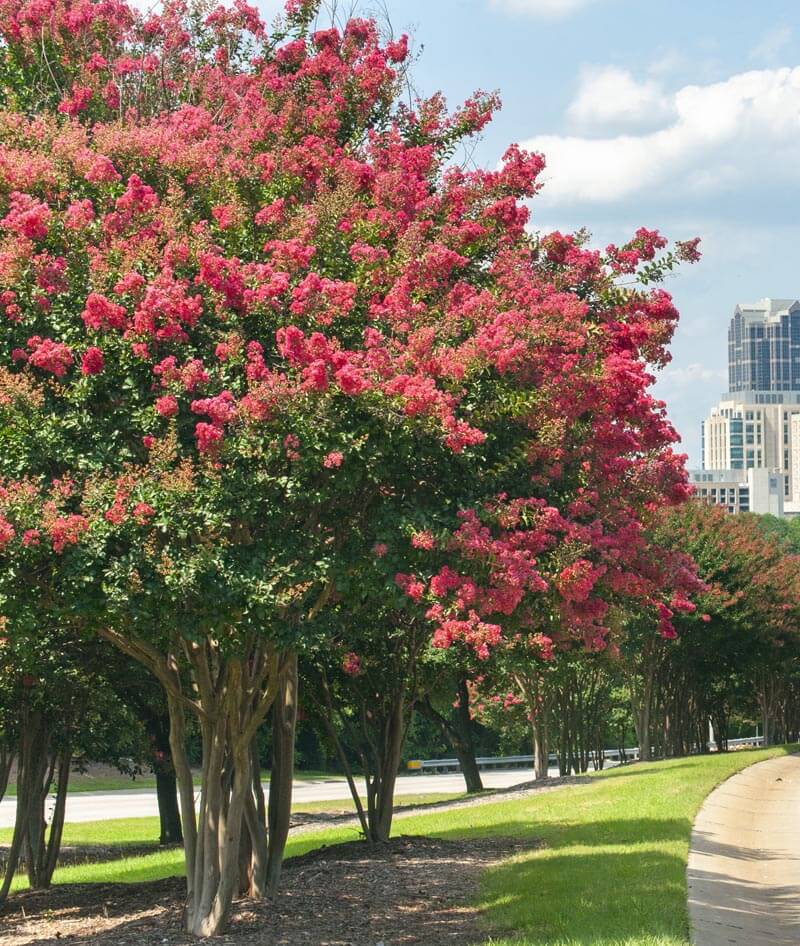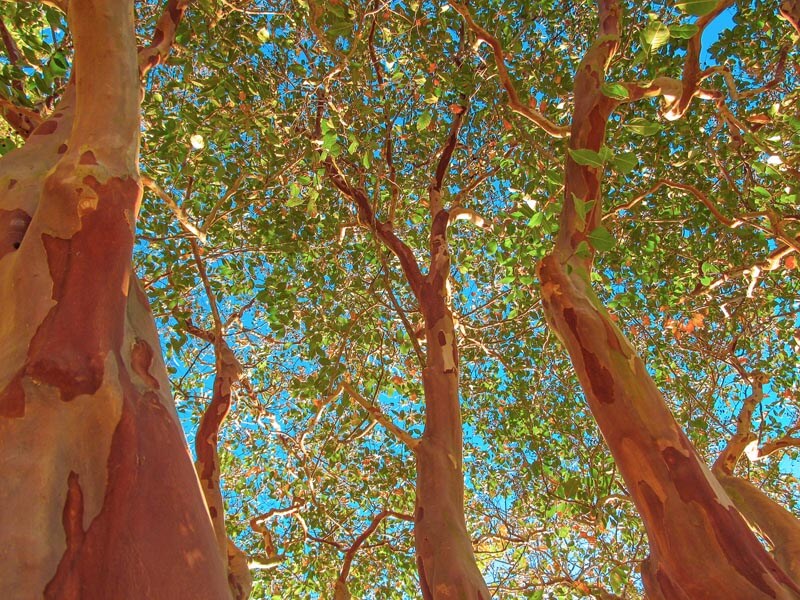
With the proliferation of spring-flowering shrubs and trees, sometimes the trees that flower in the summer can be overlooked. This is too bad because there is quite a selection of summer flowering trees from which to choose. Many people visiting our garden are often surprised to see the trees that are in bloom in July and August. So, as people visit our summer gardens, we make sure to educate them about our favorite summer-blooming trees.
Crepe Myrtle

One of my favorite summer blooming trees is crepe myrtle (Lagerstroemia indica). Perhaps thirty years ago I planted one of these small, multi-stemmed trees in my garden and at that time it was not a well-known tree in the area. It has since thrived and is now about 20 feet tall. It blooms in August and continues flowering into September with flowers that are pale lavender.
 Truly, it is the terminal clusters of small, curly edged, brightly colored flowers of white, pink, red, or lavender that really make these trees shine. But, crepe myrtles have many other desirable attributes. The leaves are often tinged with red when they open in the spring and then turn dark green as they mature. The bark is another outstanding feature. As the trees mature, the smooth grey or tawny bark begins to exfoliate, revealing a lower layer of copper-colored bark. The bicolored effect is especially attractive in winter. Plus, many crepe myrtle trees have beautiful fall leaf color of red, orange, and/or yellow.
Truly, it is the terminal clusters of small, curly edged, brightly colored flowers of white, pink, red, or lavender that really make these trees shine. But, crepe myrtles have many other desirable attributes. The leaves are often tinged with red when they open in the spring and then turn dark green as they mature. The bark is another outstanding feature. As the trees mature, the smooth grey or tawny bark begins to exfoliate, revealing a lower layer of copper-colored bark. The bicolored effect is especially attractive in winter. Plus, many crepe myrtle trees have beautiful fall leaf color of red, orange, and/or yellow.
There is one common problem that these trees may have. That is powdery mildew. While the tree in my garden sometimes gets powdery mildew, many of the new hybrids are powdery mildew resistant. Trees planted in open areas with a lot of airflow and sunlight are also let apt to get the disease. Trees also perform best in very well-drained soil. The addition of Black Gold Garden Compost Blend will increase fertility and drainage.

For many years, the U.S. National Arboretum has conducted a breeding program and introduced many crepe myrtle trees and dwarf shrubs that have been selected for winter hardiness and mildew resistance. Many of the mildew-resistant introductions have Native American names, such as ‘Zuni’ (bright purple flowers and orange-red to maroon fall leaves), ‘Tonto’ (semi-dwarf, fuchsia-red flowers, and orange-red fall leaves), ‘Hopi’ (semi-dwarf, pink flowers, extra attractive bark, and brilliant fall leaves in fiery shades), and ‘Natchez’ (white flowers, extra attractive bark, and orange-red fall leaves), and are exceptional performers in the garden. These new cultivars come in many sizes and have a wide selection of flower colors to choose from including white, red, pink, and various shades of lavender.
More recently some crepe myrtle plants have been developed for their intense black-purple foliage. Examples are Black Diamond® and Sunset Magic™. Check with your local garden center to see if any of these beautiful selections are available.
Seven Son Flower

The Chinese seven son flower (Heptacodium miconioides), is an easy-to-grow, summer-flowering tree that we do not often see, probably because it is not well known. The common name, seven son flower, is named for how the flower clusters are arranged. Smaller whorls of seven small flowers comprise the larger flower clusters. The flowers appear over a long period in the summer, from July to August, and are ivory and fragrant. They are followed by masses of attractive small fruits that appear inside rose-purple calyxes. From a distance, these calyxes look as though the tree is flowering.
There is one seven son flower in my garden that receives minimal care and still performs well. This tree can reach 15 to 20 feet tall and 10 feet wide and be trained as a single or multi-trunked specimen. The leaves are glossy green and the bark exfoliates, which is an added feature.
Harlequin Glorybower

When the harlequin glorybower (Clerodendrum trichotomum) blooms in my garden the fragrance of the flowers is almost intoxicating. Flowers appear in late July and August in white clusters. This tree also has the common name of peanut butter tree because when the leaves are crushed they have a peanut butter scent. This tree has fruits with scarlet edges that develop metallic-looking turquoise centers that will often last until after the leaves fall in autumn. It is quite a sight to see these colorful fruits on bare branches. This tree does sucker, so beware and remove suckers as soon as they appear.
Golden Rain Tree

If you have more space in your landscape, the midsummer-flowering golden rain tree (Koelreuteria paniculata) is a great choice. When mature, the trees reach a stately 30 to 40 feet–not too big and not too small. Airy clusters of golden flowers cover the tree when in bloom and are followed by interesting, drooping papery pods that are attractive in their own right. The tree’s compound leaves add textural interest and turn shades of gold, orange, and red in fall. Look for the variety ‘September’, which flowers later, from August to September.
This list offers just four examples of attractive summer-flowering trees. For more selections, visit a local arboretum. Many local garden centers will also have other suggestions for sale and are an excellent local source of information. Don’t think that flowering trees are only for spring. Extend your bloom season into summer and sometimes even into fall.



